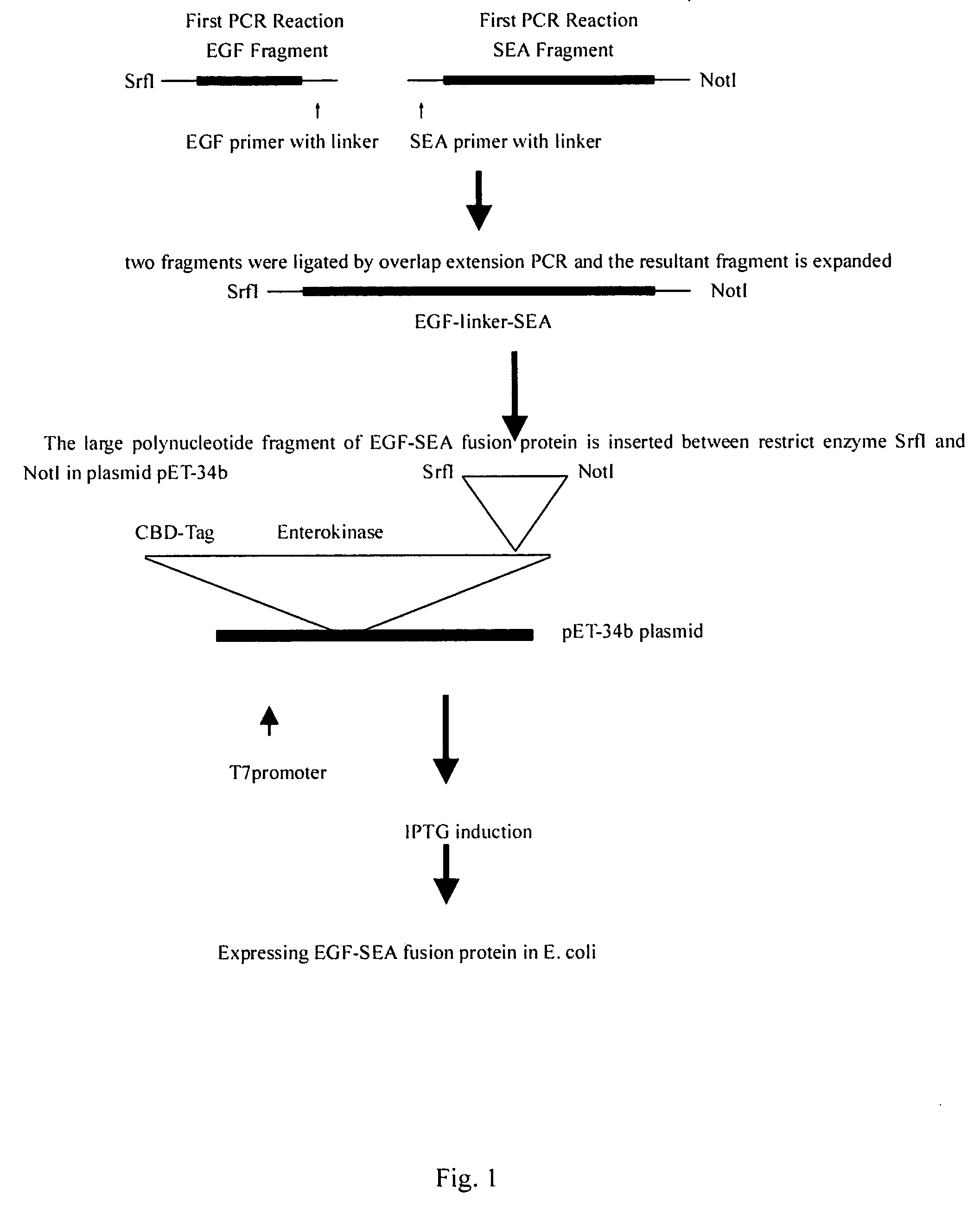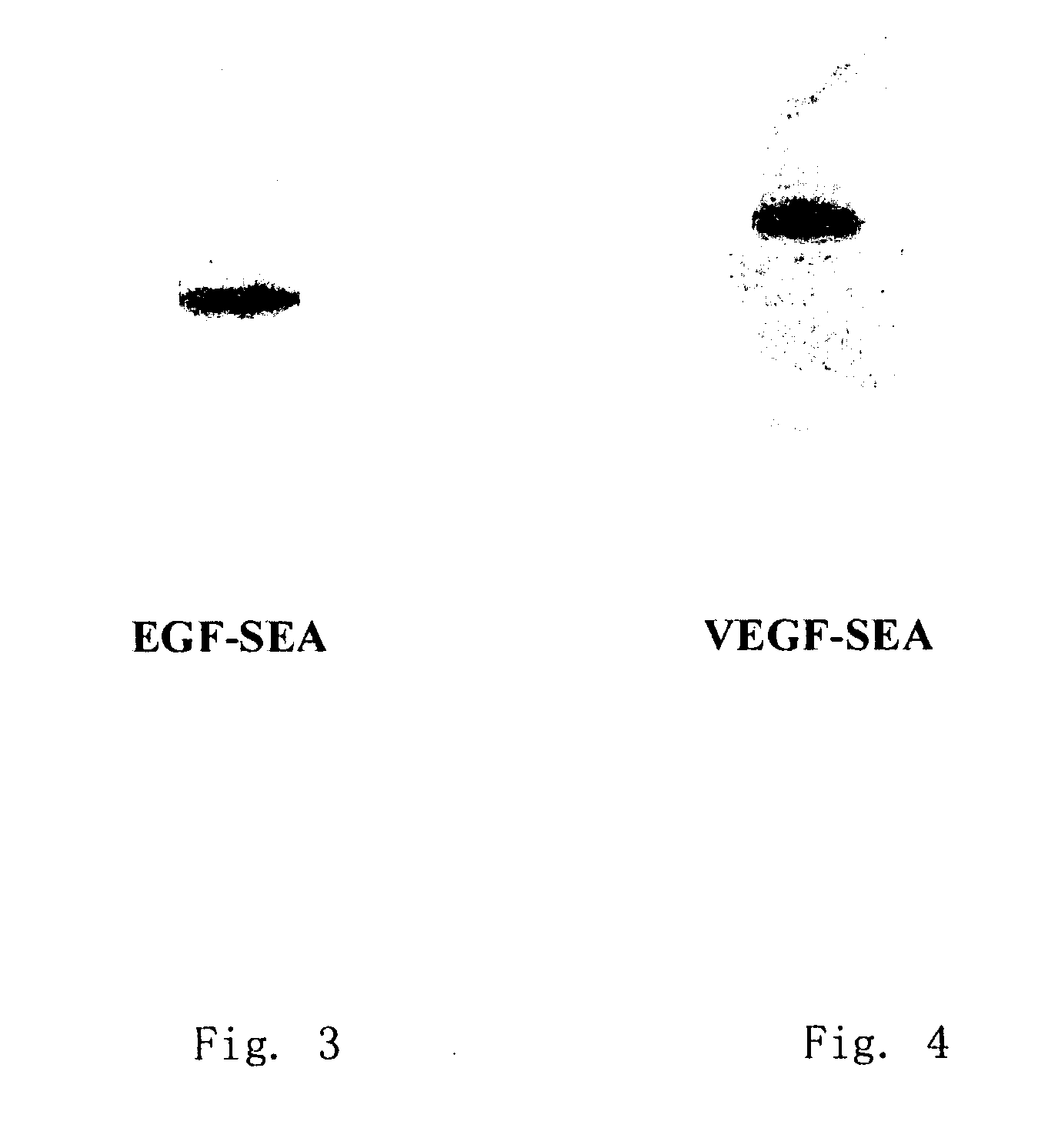Superantigen fusion protein for anti-cancer therapy and methods for the production thereof
a technology of superantigens and fusion proteins, applied in the field of molecular biology, can solve the problems of lack of cancer specificity of chemotherapeutic agents, cancer cell death of cancer cells, and cancer damage of normal cells, and achieve the effect of specific and effective tumoricidal treatment for cancer
- Summary
- Abstract
- Description
- Claims
- Application Information
AI Technical Summary
Benefits of technology
Problems solved by technology
Method used
Image
Examples
example 1
Isolation of Superantigen SEA Gene
[0059] According to conventional experimental methods of molecular biology (T. Maniatis, et al, Molecular cloning, A laboratory manual, Second edition, Cold spring harbor laboratory, 1989), DNA was prepared from Staphylococcus aureus FRI337 by phenol / chloroform extraction. Primers were designed on the basis of published superantigen SEA gene sequence (M. J. Betley and J. J. Mekalanos, J. Bacteriol., 170, 34-41, 1988):(1) forward primer containing a SrfI restrition site, 5′-GAGCCCGGGCAGCGAGAAAAGCGAAGAAATAAA T-3′(SEQ ID NO: 7); (2) reverse primer containing a NotI restriction site, 5′-GTGCGGCCGCACTT GTATATAAATATATATCAATATGCAT-3′ (SEQ ID NO: 8). The primers were used for PCR amplification of SEA gene. PCR reaction was performed with 0.1 μl template by 30 cycles of: [95° C. for 30 sec, 55° C. for 30 sec, 72° C. for 120 sec], and finished by 10 min at 72° C. The obtained DNA fragment was about 700 bp in length.
[0060] After low melting point agarose gel...
example 2
Isolation of Epidermal Growth Factor (EGF) Gene
[0061] Primers were designed on the basis of previously reported epidermal growth factor (EGF) gene sequence (J. Smith, et al, Nucleic Acids Res., 10, 4467-4482, 1982): (1) forward primer containing a SrfI restriction site, 5′-GAGCCCGGGCAA TTCCGATAGCGAGTGT-3′(SEQ ID NO:9); (2) reverse primer containing a NotI restriction site, 5′-GTGCGGCCGCTCTAAGTTCCCACCATTT-3′(SEQ ID NO: 10). EGF gene is isolated from human breast cancer cDNA gene library( Clontech Inc.) by PCR, which encodes a polypeptide of 53 amino acids. PCR reaction was performed with 0.1 μl template by 30 cycles of: [95° C. for 30 sec, 55° C. for 30 sec, 72° C. for 30 sec], and finished by 10 min at 72° C. The obtained DNA fragment was about 170 bp in length.
[0062] After low melting point agarose gel electrophoresis, the DNA product was extracted and further digested with restriction enzyme SrfI and NotI. The resulting gene fragment was then inserted into pET-34b plasmid. DNA l...
example 3
Isolation of Vascular Endothelial Cell Growth Factor (VEGF)
[0063] Primers for VEGF-121 were designed on the basis of previously reported vascular endothelial cell growth factor (VEGF) gene sequence (P. J. Keck, et al, Science, 246, 1309-1312, 1989; E. Tischer, et al, J. Biol. Chem., 266, 11947-11954, 1991):(1) forward primer containing a SrfI restriction site, 5′-GAGCCCGGGCGCACCCATGGCAGAAGGAGGA-3′ (SEQ ID NO: 1); (2) reverse primer containing a NotI restriction site, 5′-GTGCGGCCGCCCGCC TCGGCTTGTCACATTTTTCTTGTCTTGCTCTATCTTTCTT-3′ (SEQ ID NO: 12). VEGF-121 gene was isolated from human breast cancer cDNA gene library (Clontech Inc.) by PCR, it encodes a polypeptide of 121 amino acids. PCR reaction was performed with 0.1 μl template by 30 cycles of: [95° C. for 30 sec, 55° C. for 30 sec, 72° C. for 50 sec], and finished by 10 min at 72° C. The obtained DNA fragment was about 370 bp in length.
[0064] After low melting point agarose gel electrophoresis, the DNA product was extracted and ...
PUM
| Property | Measurement | Unit |
|---|---|---|
| pH | aaaaa | aaaaa |
| concentration | aaaaa | aaaaa |
| surface | aaaaa | aaaaa |
Abstract
Description
Claims
Application Information
 Login to View More
Login to View More - R&D
- Intellectual Property
- Life Sciences
- Materials
- Tech Scout
- Unparalleled Data Quality
- Higher Quality Content
- 60% Fewer Hallucinations
Browse by: Latest US Patents, China's latest patents, Technical Efficacy Thesaurus, Application Domain, Technology Topic, Popular Technical Reports.
© 2025 PatSnap. All rights reserved.Legal|Privacy policy|Modern Slavery Act Transparency Statement|Sitemap|About US| Contact US: help@patsnap.com



